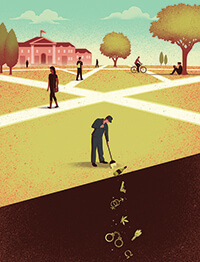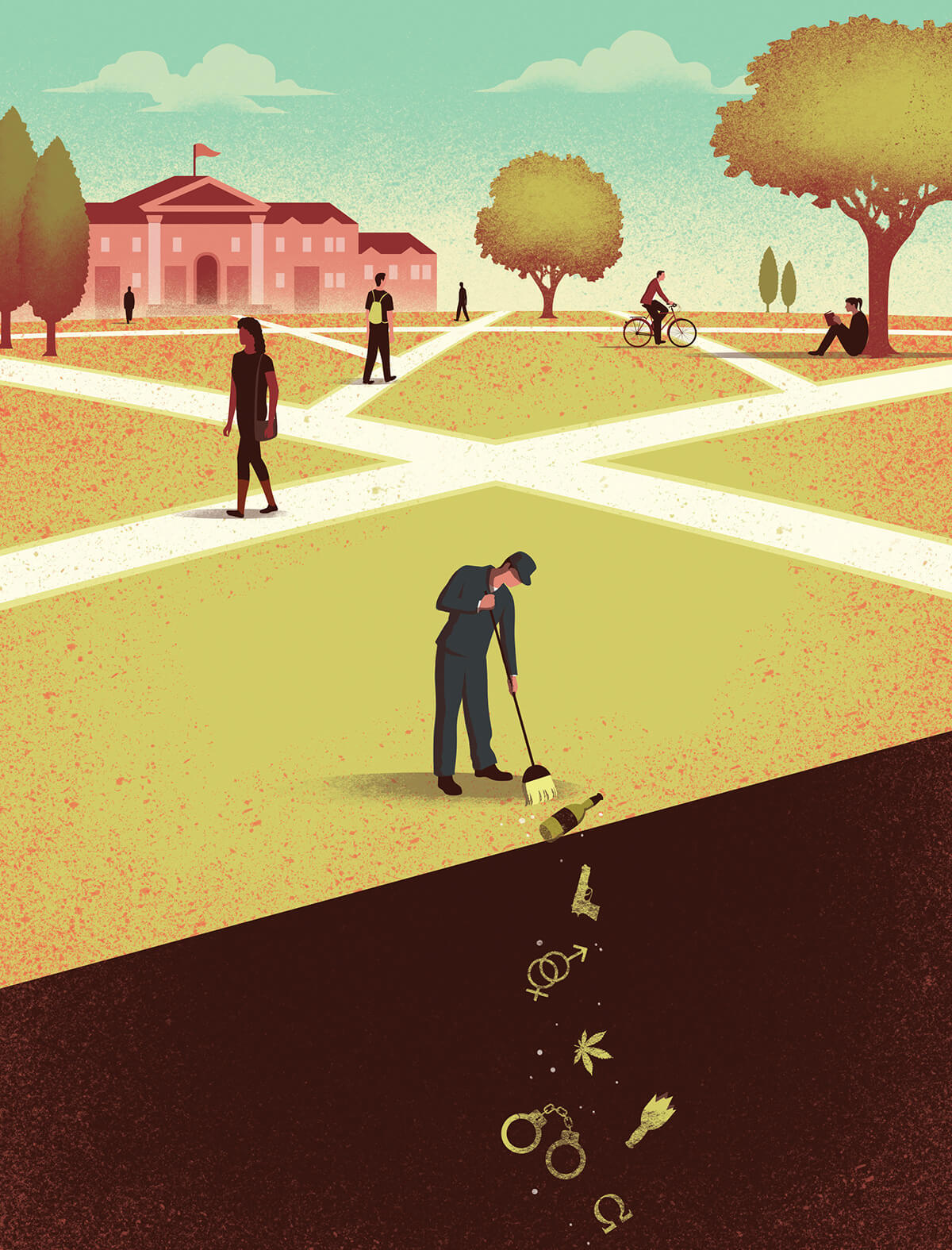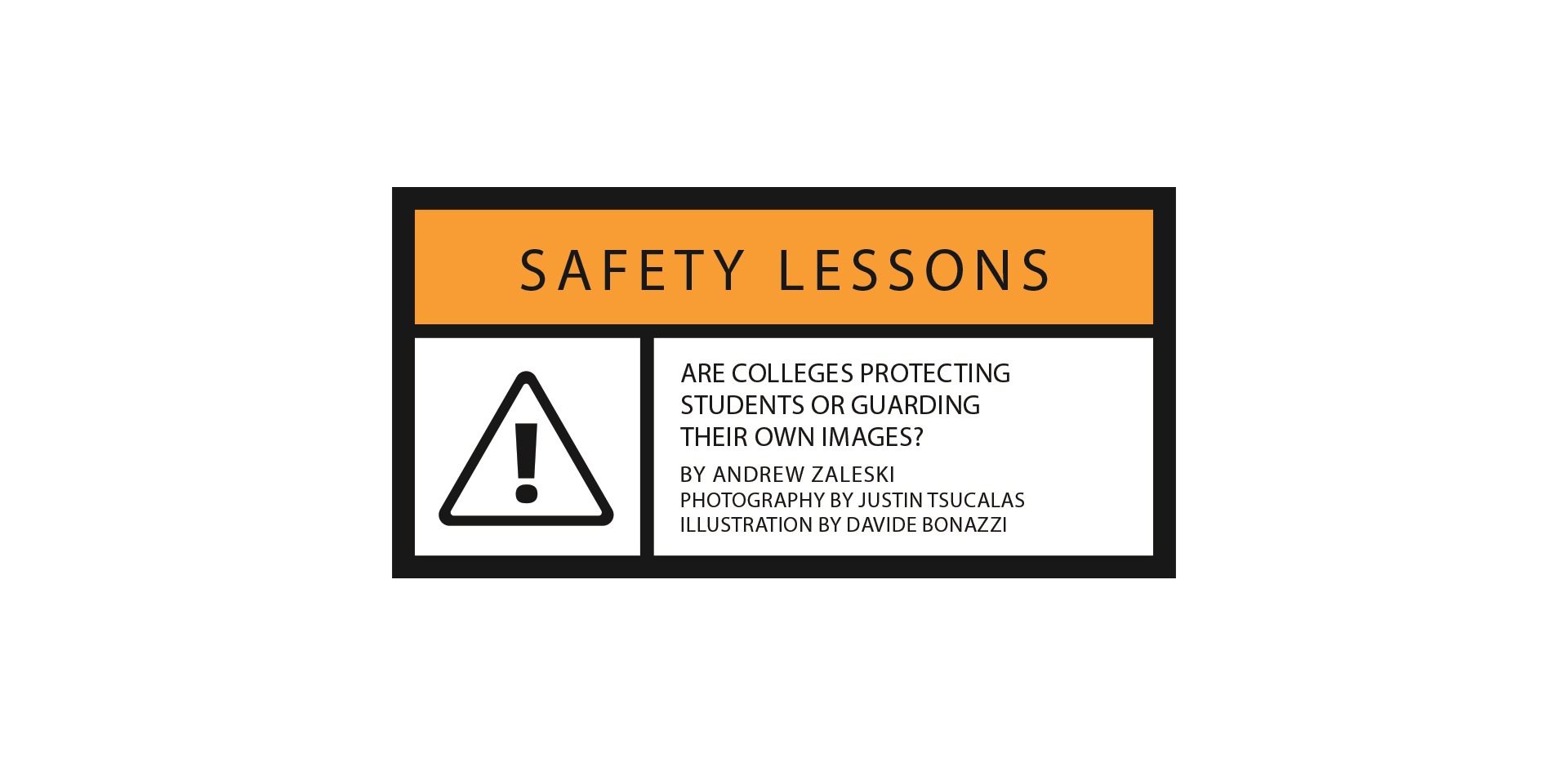
Safety Lessons
Are colleges protecting students or guarding their own images?
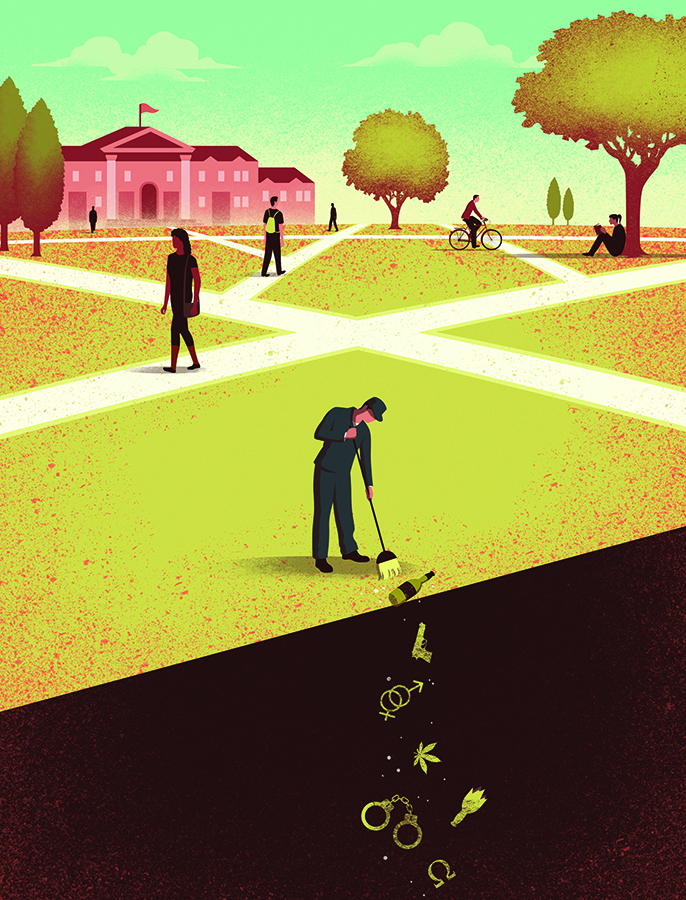
It’s Just after 10 o’clock on a recent weekend night, when Matthew Pfau, a 26-year-old officer with the University of Maryland, College Park, campus police, gets his first, utterly conventional call of the night: A student is smoking pot. A resident assistant in a high-rise dormitory noted the distinct smell of marijuana wafting through the door of a freshman’s room. Donald Sutherland’s stoner professor from Animal House would be proud, even if the Class of 2020 doesn’t remember Sutherland or that movie. On this Friday in September, Pfau chuckles a little before speeding off in his cruiser.
“It’s usually only a small amount of marijuana,” he says.
Several minutes later, Pfau arrives at the hall, heads up four floors, and knocks on a door. An 18-year-old with bloodshot eyes and unmistakable pungency answers, but denies he has been smoking. When Pfau asks to see his campus ID card, the student flips open his wallet and accidentally reveals a Rhode Island driver’s license, which Pfau instantly spots as fake and confiscates. Finally, after a bit more coaxing, the student comes clean. “All right, I’m gonna be honest with you,” he says. “Yes, I smoked a little weed tonight.”
The fake ID is going back to the campus police station for destruction. As for the pot: Pfau will refer the freshman to the Office of Student Conduct, where he’ll explain what happened to a court of his peers. Possessing marijuana can get a student kicked out of school, but the chance of that happening on a first offense is quite low. Along with drinking beer, it’s the sort of activity most expect to find on a college campus. Pfau knows both of these things, and keeps a professional but friendly tone throughout the interaction.
This is all very typical. For the most part, college administrators and campus safety personnel, like Pfau, handle small matters such as these several times on an average weekend night, and not much else. According to the National Center for Education Statistics, a college campus is one of the safer places to be in America. A study this spring showed that higher-education crimes nationwide decreased by 8 percent from 2012 to 2013, a figure the center came up with by analyzing universities’ annual crime reports—which, along with daily crime logs and timely alerts of crimes on campus, are requirements for colleges under the federal Clery Act. Yet how schools respond to campus safety worries is increasingly on the minds of Maryland administrators and campus police—and parents.
The list of stereotypical campus safety concerns has long included issues such as binge drinking, hazing, pot smoking, and robbery. But there are others, too. Last May, a student at The Johns Hopkins University was robbed at gunpoint late at night, an incident that recalled the armed robbery of four Hopkins freshmen during their first night on campus in 2013. And over the summer, Baltimore County police charged two Towson University students from the Tau Kappa Epsilon fraternity with reckless endangerment after a hazing incident left a 19-year-old hospitalized.
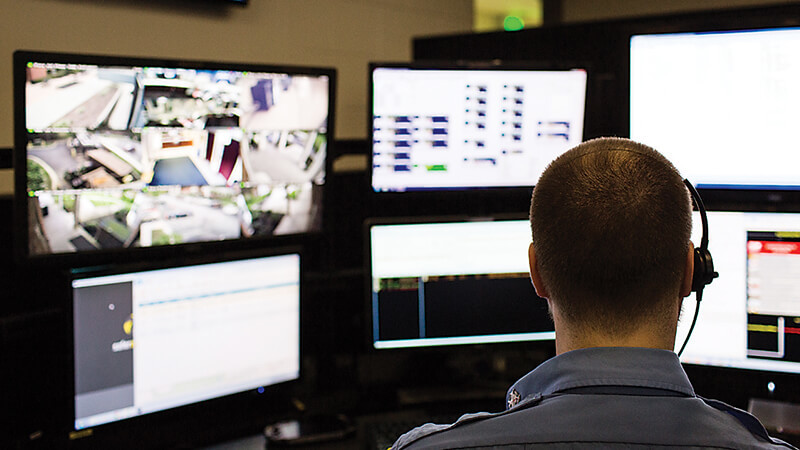
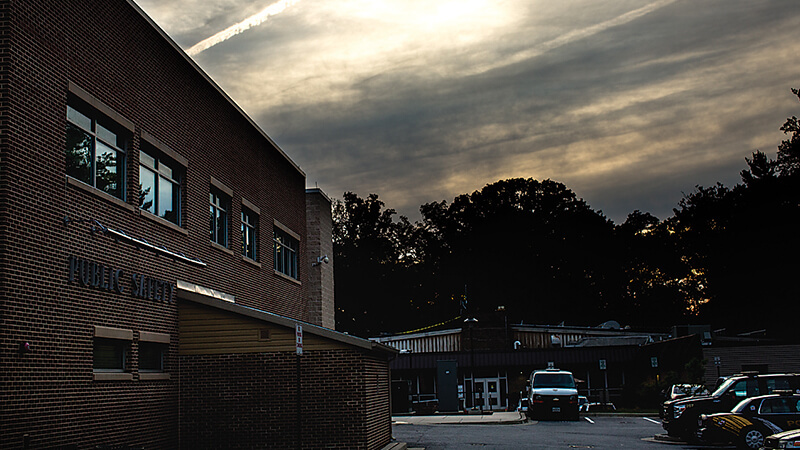

Towson University’s
electronic security center.
Today, sexual assault dominates the list of concerns. Currently, the U.S. Department of Education’s Office for Civil Rights is investigating more than 200 colleges for how they handle allegations of sexual assault, including The Johns Hopkins University, Morgan State University, Mount St. Mary’s University, St. Mary’s College of Maryland, and the University of Maryland, Baltimore County. (In September, the department’s investigation into Frostburg State University concluded with no fine, and the school was taken off the list.) All five schools are the subject of Title IX complaints brought against them by students. Under the 1972 federal Title IX law, sex-based discrimination in education is prohibited, and the Department of Education has concluded that sexual harassment and sexual assault are forms of sex-based discrimination because they can create a hostile learning environment on campus. “The issue of sexual assault the last couple of years has gotten a lot of attention,” says Saakshi Suri, co-director of the Sexual Assault Resource Unit (SARU) student group at Hopkins, which runs a campus hotline and advocates on behalf of victims. “We had way more interest [from potential student volunteers] this year than in the past.” Last year, Lili Bernard, an actress who accused Bill Cosby of sexual assault and a parent of a JHU student, reached out to SARU and worked with the group to try to convince the school to rescind his honorary degree.

Towson University
Chief of police
Bernard Gerst.
Guns are also a growing concern on campus. Last fall, for example, Washington College evacuated the campus when it got word that a missing student had left his parents’ house near Philadelphia, possibly armed with a gun. Days later, sophomore Jacob Marberger was found 80 miles from Philadelphia, dead of a self-inflicted gunshot wound, according to the Pennsylvania State Police. And, regrettably, the threat of an active shooter still looms nearly a decade since the Virginia Tech shooting that left 32 dead and 17 wounded. From 2000 to 2013, there were 12 “active-shooter incidents” at colleges and universities, according to FBI data, part of a burgeoning trend of active-shooter incidents nationwide. As a result, classroom doors are being retrofitted at Towson University so they can be locked from the inside, and it’s a requirement of all new construction, according to university police chief Bernard Gerst.
In light of ongoing safety concerns, the pressure is on colleges to respond while also maintaining their reputations and juggling multiple constituencies—chief among them parents and students.
“There’s a greater sense of the need for security on campus,” says David Heffer, director of public safety at Goucher College. “There’s always been this desire for it. But I do think because of the Title IX stuff, because of the active-shooter thing, and because we’re getting better data nowadays, we’re focusing more on developing strategies to stop some of those things, or to at least slow them down.”
The study by the National Center for Education Statistics, released in May, also documented that reported forcible, sexual crimes on campus are on the rise—from 2,200 incidents recorded in 2001 to 5,000 recorded in 2013. Greater attention has been paid to campus sexual violence in the last decade, in part because of high-profile incidents such as the sexual assault committed by a Stanford University swimmer last year. But the issue also has gained traction because of investigations the federal Office for Civil Rights (OCR) has opened into universities across the U.S. and the stress colleges feel being placed on a list of 214 schools under scrutiny.
“The damage [to a school’s image] really comes from the publicity angle of the campus. They get dinged just by being on that list,” says Robin Hattersley Gray, executive editor of the magazine Campus Safety, which hosted its third annual campus safety conference at National Harbor in Prince George’s County in July.
Campus administrators at several Maryland colleges are now revamping their sexual misconduct policies and investigatory procedures. This comes after guidelines on handling college sexual violence were issued by an Obama administration task force in 2014, the same year the OCR opened investigations into Morgan State and Johns Hopkins. Among the instructions, schools are now expected to explicitly state the evidentiary standards for investigating sexual misconduct complaints. On campus, a “preponderance of the evidence” standard is to be used, in terms of taking institutional action against a student perpetrator—rather than the more stringent beyond a reasonable doubt standard used in criminal courts.
From a campus safety standpoint, preventing, mitigating, or resolving sexual violence at colleges usually begins with a student reporting it. Ultimately, it’s up to students whether they’d like to report a sexual assault to campus administrators or to campus police departments, which sometimes work with outside police departments to investigate an assault if criminal charges are being sought. But sexual assault is underreported on college campuses. In 2014, the federal Department of Justice estimated that about 80 percent of campus sexual assaults go unreported to police, while an unknown number of students choose to report directly to campus officials seeking administrative adjudication rather than criminal charges. Sometimes, students turn to campus counselors who, except in extreme situations where a student is perceived as an imminent danger to themselves or others, are bound by confidentiality to keep the sessions private. “We give them resources and try to encourage them to go through the process of reporting—we definitely know who are the police officers and detectives who will be the most supportive on campus,” says UMBC campus counselor Doha Chibani.
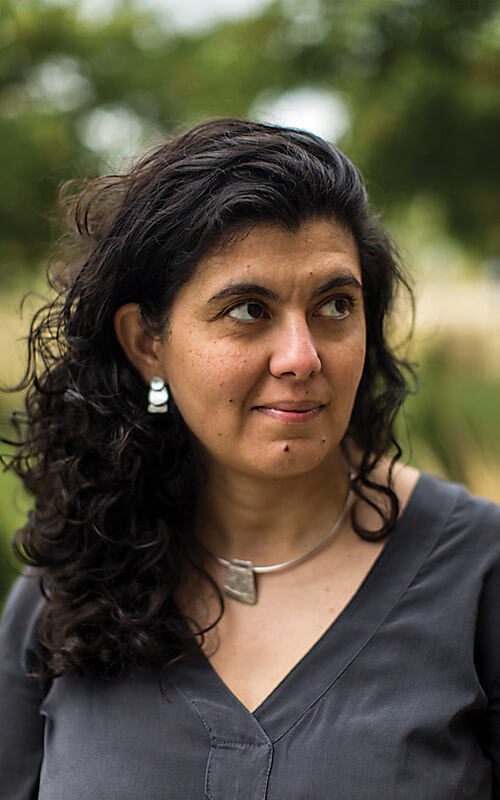
University of Maryland, Baltimore County campus counselor Doha Chibani.
In some instances, students will report a sexual assault to a campus Title IX office but aren’t looking for an investigation. What they want is help remaining in school, which can mean finding a new dorm room on campus or a class schedule that ensures they don’t need to cross paths with the student who assaulted them. But even students who report their assaults and begin an investigation have difficulty following through.
“I’ve had friends who have gotten written apologies from those who have admitted to the fact that they’ve assaulted them, and they still won’t go through the reporting process,” says McLaine Rich, a 22-year-old who graduated from UM College Park over the summer. “I’m in a very small minority in that I can say my attacker was kicked off campus. But people know the outcome is rarely what the victim is looking for, so why would they even go through this?”
Assaulted during her junior year, Rich hesitated for several months before reporting the incident in March 2015. Within a few weeks, she says, about a dozen people had approached her to share their own stories of being assaulted on campus. But Rich says going through the reporting and investigation processes with College Park’s Office of Civil Rights & Sexual Misconduct was frustrating. It took eight months from the time she reported her case until the investigation was concluded. And while Rich’s report later ended with a guilty verdict for the student who assaulted her—which led to his expulsion—she says she would go stretches without hearing anything from campus investigators.
Despite acknowledged timeline challenges—perhaps not completely surprising given the fractured nature of an academic calendar—there’s reason to believe there will be improvements at College Park. Since Catherine A. Carroll was hired in 2014 as the school’s first Title IX officer and director of its new Office of Civil Rights & Sexual Assault, her office has established new procedures to investigate cases, which seem to be yielding results.
In her first year, Carroll’s office fully investigated 18 of 48 complaints of sexual misconduct. This past year, her office fully investigated 29 of 61 complaints.
“Sexual assault cases are the hardest cases to prosecute,” says Carroll, who served as legal director of the Washington Coalition of Sexual Assault Programs and cofounded the Sexual Violence Law Center in Seattle. “When students do want to go forward with an investigation, you have to know what you’re doing and be really well-trained. And I think that’s a tall order for most institutions to make.”
Some college administrators think they can have an effect on curbing sexual violence by influencing campus culture. A few of the strategies they’ve implemented: providing educational resources at student orientations and throughout the academic year to teach students about consent and what sexual misconduct looks like, and teaching students how to intervene when they think they are witnessing a sexual assault. It’s worth noting that sexual assault on campus is not typically strangers on students; nearly 80 percent of the time, the offender is known to the victim, as a friend or acquaintance.
At UMBC, for example, all incoming students must take an online course on sexual assault prevention that covers topics such as stalking, jealousy, sexual misconduct, and relationship violence. In-person workshops, run out of the counseling center, also are available. The school is currently the subject of a complaint filed in July with the Department of Education about its alleged mishandling of sexual assault reports. But since 2011—just one year after University of Virginia student and Baltimore County native Yeardley Love was beaten to death by an ex-boyfriend—UMBC has offered grant-funded on-campus trainings on preventing relationship violence. An expansion in 2013 to the national Clery Act added dating violence, domestic violence, sexual assault, and stalking to the list of daily and annual crime statistics colleges must keep.
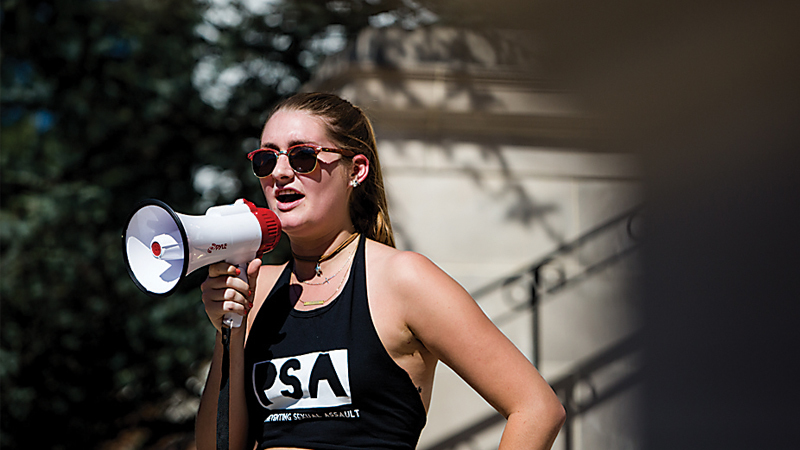
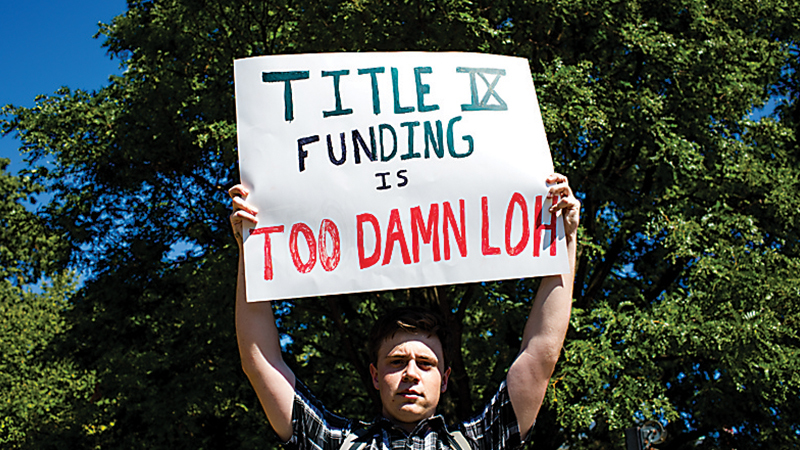
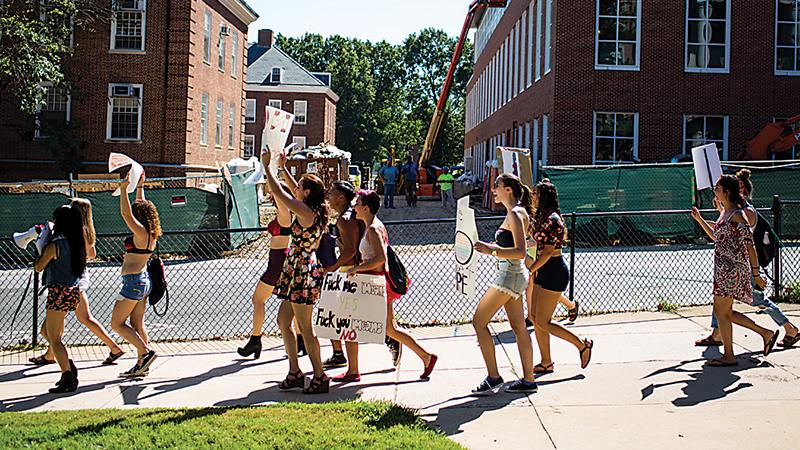
Former University of Maryland, College Park, Student Mclaine Rich leads a sexual assault prevention rally on Campus this fall.
Sitting above all this is the overwhelming presence of alcohol on a college campus. A number of colleges, including UMBC, St. Mary’s College, Johns Hopkins, and Towson University, are members of The Maryland Collaborative to Reduce College Drinking and Related Problems, a program funded by the state’s Department of Health and Mental Hygiene to educate students on how alcohol can be an ingredient to sexual assaults and a swath of other campus safety problems.
“The research shows there’s a strong connection. It doesn’t cause sexual assault, but it can be a contributing factor,” says Michael Dunn, Title IX coordinator at St. Mary’s.
“The problem isn’t a freshman having their first beer, for the most part we don’t know that. The problem is drinking a dozen,” says UM College Park police chief David B. Mitchell. “The greater the [blood-alcohol content], the higher odds are something bad will come of it.”
Former University of Maryland, College Park, Student Mclaine Rich leads a sexual assault prevention rally on Campus this fall.
Of course, campus safety sits in a weird middle ground of personal development, where students are legally recognized as adults and yet still growing up—and trying to have a good time. How to strike that balance between watching over the students and alleviating parents’ fears is the question. Campus alert systems, where all students—and, in some cases, their parents—receive text, voice, social media, and e-mail notifications have been put in place. The Clery Act is pretty clear on when alerts must be sent: in the face of an immediate emergency, which could be something like a tornado warning, or if there’s an ongoing threat to the campus community, like an active shooter.
Still, it’s difficult to gauge how safe a campus is overall. While the Clery Act mandates that colleges report crime statistics—“a lot of times they don’t because it looks bad to prospective students,” says Campus Safety magazine’s Gray.
“There’s a concern because, if the stats are high, then people will be afraid to go to their campuses,” she says.
Still, Maryland colleges appear to have good track records. Violent crime data collected by Towson University for the year 2014 shows that UM College Park, the largest state school in terms of student enrollment, recorded 0.13 violent crimes per 1,000 students. At Towson, the second-largest with more than 22,000 students, the ratio was 0.31 per 1,000 students.
Maryland colleges also have begun experimenting with keeping students safe in innovative ways. At The Johns Hopkins University, a mobile app for iOS and Android users allows students to submit anonymous tips to campus security, request police escorts while walking the campus, and even do a “safe walk,” where friends and family can track their precise location using GPS. Introduced this fall, the app has been downloaded more than 2,300 times already, says Lee James, executive director of campus safety and security.
At Frostburg State and UM College Park, campus police wear cameras. More schools are also turning to on-campus surveillance cameras, similar in function, if not appearance, to the blue light cameras that are fixtures in some Baltimore neighborhoods. Goucher College just installed its own cameras over the summer—public safety director Heffer declined to share the precise number—while UM College Park and Towson University have more than 500 and 1,200 cameras, respectively, on their campuses.
“Those surveillance cameras are worth their weight in gold,” says Towson police chief Gerst. “If a crime does occur, it will help us do a much, much better job [of finding the suspect].”
How to monitor students who choose to live off-campus is still something Maryland colleges struggle with. For the past year, a consortium of Baltimore City Community College plus eight universities in Baltimore City—where robberies are up 12 percent this year—has been meeting with the Baltimore Police Department to share information about off-campus crime trends. That might be where gang activity is proliferating or where vehicle threats have been popping up recently. The program will probably become more important given what happened this fall when 21-year-old Morgan State University student Marcus Edwards was found stabbed to death off-campus on Loch Raven Boulevard and UMBC student Jackson Bleier, a Federal Hill resident, was shot and killed in Southwest Baltimore. “With the consortium, the goal is information,” says Morgan’s Adrian Wiggins, executive director of campus and public safety. “Sharing on those issues could potentially impact large groups of persons. For instance, we receive a lot of intelligence info about places students should or should not go.”
Despite the sometimes tragic headlines, a college campus is generally a safe space for students. A stolen book bag or laptop is probably the most common threat. “Ask chiefs what is the most common problem on a college campus—it’s opportunistic thefts,” says Gerst. “People feel safer on a college campus [than in many places].”
On that Friday night in September, as Officer Pfau turns to head back down the hallway to the elevator that will take him outside and back to patrolling College Park, he spots a student who exits his room without closing his door and calls out to him, asking if he wants his door shut. The student says he’s coming right back, and does—and that’s when Pfau turns to go.
“College kids, they’re thinking in the moment. It’s better to just talk with them,” he says. “As corny as it sounds, we are here to make sure they wake up and go to class.”
